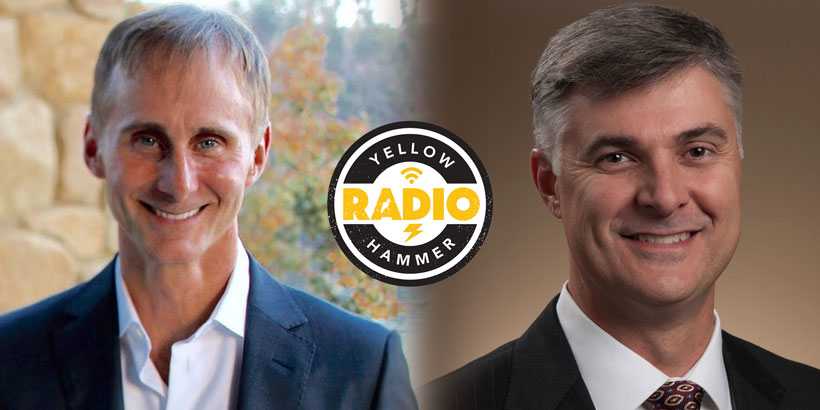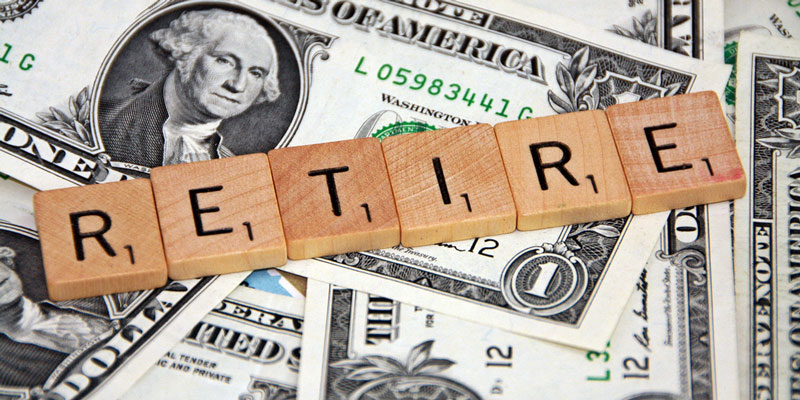Birmingham, Alabama-based financial guru Jeff Roberts, who was recently named one of the top private wealth advisors in the nation by Barron’s®, came on Yellowhammer Radio Tuesday to lay out the facts so people can decide for themselves.
The full conversation with Mr. Roberts can be heard on the Yellowhammer Radio podcast or in the video above, and a lightly edited transcript of his interview with Yellowhammer’s Cliff Sims can be read below.
Subscribe to the Yellowhammer Radio Podcast on iTunes. Learn more about Jeff Roberts’ private wealth advisory practice at JeffRobertsAndAssociates.com.
Scott:
For the last couple weeks we’ve been discussing retirement planning and I’m telling you, the things that you’ve said meant so much to me. I’ve always thought retirement planning was, okay save as much as I can and just ride it out. You’ve pointed out that it’s not quite so simple but there have been many lessons. Two big ones, you should begin planning as early as possible and retirement planning continues throughout retirement. That’s something I had not thought about. But today, we’re just going to talk about how crucial those points are. Is that right?
Jeff:
You’ve got it, brother. The key issue is making sure people understand the accumulation phase of retirement, which happens before retirement and the distribution phase, which happens once you are retired. And as you eloquently put they are two completely separate components to retirement planning.
Scott:
We talked about those. Those two segments of retirement planning, we’ve covered a lot of ground and I hope people will go listen to the podcast, it’s up at YellowhammerRadio.com so you can get these things. I know a lot of people have asked me, ‘Hey look, I listed to you and Jeff Roberts but I’m in and out of the car how could I find out more about it?’ So folks remember, it’s up over at YellowhammerRadio.com. What more do we need to know than the things we’ve talked about the past couple weeks?
Jeff:
Good question. The big piece today and what I’m going to drill down on is helping people to understand exactly why it is so critical to start early and why you must continue to plan for retirement in retirement.
Scott:
You’re talking to people like me and you’re a private wealth advisor. What are most people doing wrong? And I’m sure it’s going to apply to me but what are most people doing wrong?
Jeff:
I won’t pic on you today but I might use you as an example a couple times today. People commonly do not understand the impact of time on their retirement plans and that’s what today’s lesson is going to be about. Not correctly taking advantage of the time that they have to plan before they retire and then not correctly planning for the impact of time on their retirement plans once they retire. So today I’m going to speak to both people that are pre-retirement and the people that are in retirement. So bare with me as I explain this because it’s going to take a minute and there will be some numbers I’m going to throw out and I might use you as an example. People must understand the power of compounding returns and there is nothing better to aid in that concept than our old friend Rule 72. And the Rule of 72 is very simple. It is a simplified way to approximate how long an investment will take to double given a 6% annual rate of return. Let me walk you through this and then I’ll explain why it is so crucial to both your accumulation phase and distribution phase. So you divide the number 72 by whatever annual return so investors can get a rough estimate of how many years it’ll take for their initial investment to duplicate itself or to double in other words. Let me give you an example, pretend you went to the bank and purchased a CD with $100,000 of your money. I could ask just the general audience, do you have any idea of what interest rate a twelve month CD at the bank is paying right now? And I’ll save you the research, I looked to see in Birmingham and surrounding cities. I’ve seen somewhere around a rate of .3% and 1% if you tied your money up for a year in a CD. And maybe 1.25% if you were shopping different banks, CDs for one year on the internet. Now of course those aren’t me offering those rates or anything like that it’s just hypothetical numbers in what we’re seeing. Okay, so let’s keep the math simple. As soon as you buy a certificate or deposit at 1% hypothetically. So to determine how long it’s going to take your $100,000 in the CD paying %1 to double all you do is apply our friend, Rule 72 and divide 72 by that number 1 which represents the 1%. And Scott what do we get if we divide 72 by 1?
Scott:
That’s tough math, Jeff but I’m going to go with 72.
Jeff:
You are a genius. You are a scholar indeed.
Scott:
I’m glad you kept it easy numbers.
Jeff:
I’m not putting you on the spot. We’re not going to complicate stuff. So you’re correct. 72 divided by 1 is 72. So if you have $100,000 invested in a rate of return at 1%, your $100,00 will double one time in 72 years. One double. Now, let’s change the scenario. Let’s pretend like the banks we’re actually paying 3% on their CDs for one year which they’re most likely not. Before the 2008 global financial crisis 3% on a one year CD was not uncommon. So if you put your money, $100,000 earning 3%, we divide 72 by 3 and this time, Scott what do you get?
Scott:
I’m going to go with 24 since I have a calculator with me.
Jeff:
You’re spot on. Correct again. If you have $100,000 invested at 3% it’ll double one time in 24 years, approximately in 24 years it’ll give you $200,000.
Scott:
Yeah but Jeff if you’re 40 years old you’re only going to have 24 years until you retire so you better get more than that if you want your money to double.
Jeff:
Exactly and here lies the problem. Follow me on this as I walk through it. Most Americans fail to get the last double of their money that they need to retire with financial independence and confidence throughout their life. In fact base on my personal experience working the last 24 years in financial planning I would say most Americans fail to get the last two doubles of their nest egg that they need to retire comfortably throughout their life. The last doubles of your money count the most. Let’s play a game with the numbers. So I have to ask a rhetorical question to our listening audience and for illustration purposes pretend like you didn’t have any social security and on rare occasion there’s a company pension plan which let’s remove pensions and social security from this discussion. Just ask yourself this, if you’re 60 years old can you retire today with $250,000 total in retirement savings and let’s comfortably throw out your life expectancy. And most people would say, ‘Yeah, probably not.’ Alright, then double that, let’s get one more double. Let’s go from $250,000 to $500,000. Can you retire with $500,000 total in retirement savings and live a long life in retirement and be comfortable? Well, maybe maybe not. Let’s double that. Can you retire with $1M in total retirement savings. Now, many people will say, ‘Well, yeah I can do that with a million bucks.’ But remember, let’s go back to our discussion last week. Most people when getting a lump sum of a million bucks you should only carve off safely, off your nest egg, at most a 4% annual distribution. And remember, in low interest rate environments like we’re in right now that number should even really be a maximum of 3% or slightly less. So if you have a million bucks, because we doubled our money but to a million bucks enough times, that’s only $30,000 a year. Well $40,000 a year if you’re stretching it. So then let’s say we double to two million bucks to try and get $60,000 or $80,000 a year in income when we’re retired. My point is that most of us are going to need a substantial amount of money built up and if we’re going to have a shot at maintaining our pre-retirement lifestyle and to get there people need to save a bunch and are going to need to have plenty of doubles.
Scott:
So the ability to double our savings over and over is crucial but how do people miss this? I understand it but how do people miss it?
Jeff:
It’s primarily because you can’t see the progress that’s occurring as you make doubles early on because the doubles are of a small number. So when you go up from $2,000 to $4,000, $4,000 to $8,000, $8,000 to $16,000 you’re not feeling that as much because the numbers are small compared to when you’re going from $200,000 to $400,000, $400,000 to $800,000. So the earlier victories you’re not feeling. Secondly, most of us haven’t done the math to realize how many doubles that we need to get. And they haven’t calculated the time that they have within to work. Like you were just saying from then before, you’ve only got 24 years or so before I retire so we have got to realize here’s the time table how many more doubles do I need to get? So Scott, let’s do another example, hypothetical. So Scott you have in your pocket right now $500,000 in cash, right now in your pocket.
Scott:
Oh heck yeah man. I like this. Do my wife and kids know about this money?
Jeff:
I’m going to say for this example we’re going to keep it our secret.
Scott:
That’s a good plan.
Jeff:
Now in fact you and I are having lunch together talking about our secret money and we’re talking about what we want to do with it because it’s literally burning a hole in our pockets. Only I have $100 and you have $500,000. We both agree that we need to save our cash so we go see a financial advisor and pretend with me for a second that we invest our money in some magical portfolio that gives us an 8% annual rate of return on our money. Now again, this is just hypothetical. So take 72 divided it by the 8% that gives us the number 9. So 9 years later after we had lunch together and made that investment with the advisor we cash our money out. We cash our money out 9 years later and we’re having lunch together again. Now you have $1M in your pocket 9 years later and I have $200. How are you feeling?
Scott:
I’m feeling great. I’ve got 2 commas worth of money now.
Jeff:
Exactly and how am I feeling with my $200? Well I’m feeling that you’re going to be buying my lunch.
Scott:
I was probably going to make you buy because that’s how I got my first $500,000 was mooching off of everyone else.
Jeff:
Each of us just got one double. I hardly noticed mine and yours starts to change the game a little bit. Scott, you and I are around the same age and my friend, that $1M that we were talking about in your example is likely not enough savings for you to retire and maintain your current standard of living. You need another double of that my two maybe three depending on your own personal goals. Maybe you’ve heard of the penny challenge which is this, this is another good illustration. Which would you rather have, would you rather have $100,000 on December 1st or the lump sum of money at the strike of New Years 30 days later determined by taking a penny a day, on the first day, and doubling every day for a month? So day 1, 1 penny. Day 2, 2 pennies. 4 pennies on day 3. 8 pennies, 16 and doubling each day for one month. Which would you rather have, $100,000 on December 1st or the lump sum on the 31st? Now, most people say, ‘I love $100,000 but I think I’m going to be better off if I do that lump sum even though I’m not sure how much it is.’ Any clue how much money that is after 31 days of doubling?
Scott:
I have no idea because I would have gone with the $100,000.
Jeff:
The lump sum that occurs starting with one penny and doubling every day for a month from the first day is $10,700,000 in change. And it’s amazing to think about that. I’ve got some analytics out there that the audience is likely going to have to get out their excel spreadsheets and do math and make sure but I promise it works. What’s amazing is that if you look at the trend and I mentioned 1 penny, 2 penny, 4, 8, 16, 32 pennies. What’s amazing is on Christmas Day on the 25th you’ve built up $167,000 which is a long way from the $10M but it just shows you how those last doubles are so huge. On the 28th day of the month you have $1.83M and then 3 days later you have $10.7M. Those last doubles are huge and again, most Americans fail to get the last double or two that they need before they retire.
Scott:
Well this makes sense. So that’s why you said earlier that people commonly do not understand the impact of time on their retirement plan. I would not have guessed that what you just told me even though it makes sense.
Jeff:
Let’s just keep it simple for a moment. For folks that are working towards retirement, you are on a clock. And it’s just like a shot clock in basketball or a play clock in the college football games in that you have a limited amount of time and if you want to win then you better put a lot of points on the board or in this case build a nest egg large enough that you can retire. So let’s say that you’re gonna work until you’re 65 years of age. You’re 35 today that means you’ve got 30 years if you make all the right decisions. Now, if you’re 45 years of age well now you’ve got 20 years to make all of the right decisions and if you’re 55 years of age and you retire at 65 you only have 10 years. To get what ever doubles that are necessary before you retire and many people are not starting soon enough and making the right decisions. And keep in mind when you’re at 55 and you only have 10 years left to build your nest egg and double it that’s a time when people are dialing back the risk in their portfolio as opposed to taking more risk in their portfolio.
Scott:
This all makes perfect sense. I’ve been in the accumulation phase and I know we’re gonna talk about this as we move forward, Jeff. And these are things that people are asking about. Do you have any last thoughts before we go to our break?
Jeff:
Just basically this, when in doubt go to JeffRobertsandAssociates.com. On our main page we have a 3 minute confident retirement check. It helps you figure out how confident you are towards your own future and compare that to other people’s. so if we can help in anyway dial us as 205-313-9150 for a complimentary consultation.













